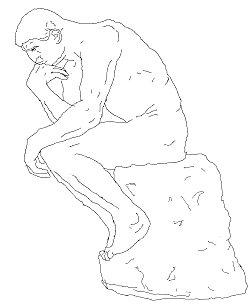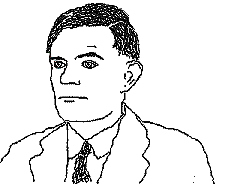 Neurocritic asks a great question here, neatly provoking that which he would have defined – thought. What is thought, and what are individual thoughts? He quotes reports that we have an estimated 70,000 thoughts a day and justly asks how on earth anyone knows. How can you count thoughts?
Neurocritic asks a great question here, neatly provoking that which he would have defined – thought. What is thought, and what are individual thoughts? He quotes reports that we have an estimated 70,000 thoughts a day and justly asks how on earth anyone knows. How can you count thoughts?
Well, we like a challenge round here, so what is a thought? I’m going to lay into this one without showing all my working (this is after all a blog post, not a treatise), but I hope to make sense intermittently. I will start by laying it down axiomatically that a thought is about or of something. In philosophical language, it has intentionality. I include perceptions as thoughts, though more often when we mention thoughts we have in mind thoughts about distant, remembered or possible things rather than ones that are currently present to our senses. We may also have in mind thoughts about perceptions or thoughts about other thoughts – in the jargon, higher-order thoughts.
Now I believe we can say three things about a thought at different levels of description. At an intuitive level, it has content. At a psychological level it is an act of recognition; recognition of the thing that forms the content. And at a neural level it is a pattern of activity reliably correlated with the perception, recollection, or consideration of the thing that forms the content; recognition is exactly this chiming of neural patterns with things (What exactly do I mean by ‘chiming of neural patterns’? No time for that now, move along please!). Note that while a given pattern of neural activity always correlates with one thought about one thing, there will be many other patterns of neural activity that correlate with slightly different thoughts about that same thing – that thing in different contexts or from different aspects. A thought is not uniquely identifiable by the thing it is about (we could develop a theory of broader content which would uniquely identify each thought, but that would have weird consequences so let’s not). Note also that these ‘things’ I speak of may be imaginary or abstract entities as well as concrete physical objects: there are a lot of problems connected with that which I will ignore here.
So what is one thought? It’s pretty clear intuitively that a thought may be part of a sequence which itself would also normally be regarded as a thought. If I think about going to make a cup of tea I may be thinking of putting the kettle on, warming the pot, measuring out the tea, and so on; I’ve had several thoughts in one way but in another the sequence only amounts to a thought about making tea. I may also think about complex things; when I think of the teapot I think of handle, spout, and so on. These cases are different in some respects, though in my view they use the same mechanism of linking objects of thought by recognising an over-arching entity that includes them. This linkage by moving up and down between recognition of larger and smaller entities is in my view what binds a train of thought together. Sitting here I perceive a small sensation of thirst, which I recognise as a typical initial stage of the larger idea of having a drink. One recognisable part of having a drink may be making the tea, part of which in turn involves the recognisable actions of standing up, going to the kitchen… and so on. However, great care must be taken here to distinguish between the things a thought contains and the things it implies. If we allow implication then every thought about a cup of tea implies an indefinitely expanding set of background ideas and every thought has infinite content.
Nevertheless, the fact that sequences can be amalgamated suggests that there is no largest possible thought. We can go on adding more elements. There’s a strong analogy here with the formation of sentences when speaking or writing. A thought or a sentence tends to run to a natural conclusion after a while, but this seems to arise partly because we run out of mental steam, and partly because short thoughts and short sentences are more manageable and can together do anything that longer ones can do. In principle a sentence could go on indefinitely, and so could a thought. Indeed, since the thread of relevance is weakened but not (we hope) lost at each junction between sentences or thoughts, we can perhaps regard whole passages of prose as embodying a single complex thought. The Decline and Fall of the Roman Empire is arguably a single massively complicated thought that emerged from Gibbon’s brain over an unusually extended period, having first sprung to mind as he ‘sat musing amidst the ruins of the Capitol, while the barefoot friars were singing vespers in the Temple of Jupiter’.
Parenthetically I throw in the speculation that grammatical sentence structure loosely mirrors the structure of thought; perhaps particular real world grammars emerge from the regular bashing together of people’s individual mental thought structures, with all the variable compromise and conventionaljsation that that would involve.
Is there a smallest possible thought? If we can go on putting thoughts together indefinitely, like more and more complex molecules, is there a level at which we get down to thoughts like atoms, incapable of further division without destruction?
As we enter this territory, we walk among the largely forgotten ruins of some grand projects of the past. People as clever as Leibniz once thought we might manage to define a set of semantic primitives, basic elements out of which all thoughts must be built. The idea, intuitively, was roughly that we could take the dictionary and define each word in terms of simpler ones; then define the words in the definitions in ones that were simpler still, until we boiled everything down to a handful of basics which we sort of expected to be words encapsulating elementary concepts of physics, ethics, maths, and so on.
Of course, it didn’t work. It turns out that the process of definition is not analytical but expository. At the bottom level our primitives turn out to contain concepts from higher layers; the universe by transcendence and slippery lamination eludes comprehensive categorisation. As Borges said:
It is clear that there is no classification of the Universe that is not arbitrary and full of conjectures. The reason for this is very simple: we do not know what kind of thing the universe is. We can go further; we suspect that there is no universe in the organic, unifying sense of that ambitious word.
That doesn’t mean there is no smallest thought in some less ambitious sense. There may not be primitives, but to resurrect the analogy with language, there might be words. If, as I believe, thoughts correlate with patterns of neural activity, it follows that although complex thoughts may arise from patterns that evolve over minutes or even years (like the unimaginably complex sequence of neural firing that generated Gibbon’s masterpiece), we could in principle look at a snapshot and have our instantaneous smallest thought.
It still isn’t necessarily the case that we could count atomic thoughts. It would depend whether the brain snaps smartly between one meaningful pattern and another, as indeed language does between words, or smooshes one pattern gradually into another. (One small qualification to that is that although written and mental words seem nicely separated, in spoken language the sound tends to be very smooshy.) My guess is that it’s more like the former than the latter (it doesn’t feel as if thinking about tea morphs gradually into thinking about boiling water, more like a snappy shift from one to the other), but it is hard to be sure that that is always the case. In principle it’s a matter that could be illuminated or resolved by empirical research, though that would require a remarkable level of detailed observation. At any rate no-one has counted thoughts this way yet and perhaps they never will.

 Are our minds being dumbed by digits – or set free by unreading?
Are our minds being dumbed by digits – or set free by unreading?